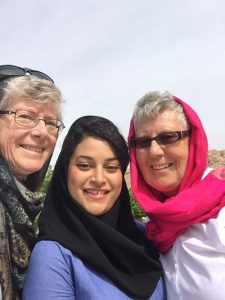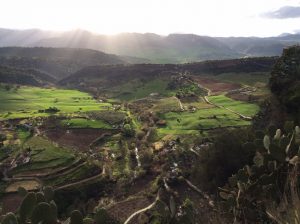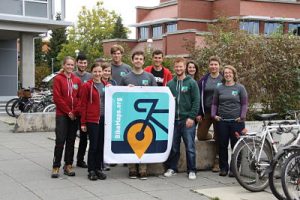The Cross Canada Cycle Tour Society May 2016, Volume 33, Issue #5
President’s Report John Pringle
Spring General Meetings. Occasionally the truth hurts. I was thanking one of our Club members for his participation at the spring general meeting, held 11th April in Sidney BC. Why, I naively asked, was there such a poor meeting turn out: Only ~35 members attended of ≥300 members living in the catchment area (southern mainland/Vancouver Island) who, with some effort, could’ve attended? “Most people hate meetings.” he replied. He went on to say we should try promoting the meeting, “… as a fun event rather than just a boring meeting … Call it a Bikeapalooza … (Have) real food … rather than … sandwich plates … encourage everyone to bring their bikes … (Have) some sort of riding event … Perhaps a mini (two-day) hub & spoke … mainland(ers) could come over the day before and we could organize … rides.” I’ve reflected for some time on his comments. Is that what it would take to bring Club members together, for about 1.5 hours, to advise them of the cycling events planned for their cycling season? To allow them input to their Club’s governance. To allow democracy to take place. Board members too, might find general meetings boring, and quite frankly a pain to organize and attend each spring? Board members who organize and prepare illustrated talks, in an attempt to make meetings less boring, might well think their time could be more gainfully employed elsewhere when turnout is so disappointingly low.
The Club’s Constitution dictates that a “general meeting shall be held at least once in every calendar year.” Any other general meeting is deemed an ‘Extraordinary General Meeting’ (SEGM). Our Spring Extraordinary General Meetings were conceived some years back to, in part, present the cycling season’s events – the when, where and who’s-leading each of the year’s hub & spokes and tours. Given that many of our events are now well advertised long before the SEGM; and that a goodly number of them are well subscribed to prior to these meetings, suggests that spring meetings may indeed be redundant. But what of the Board member who has recently spent countless hours developing our new and most useful website. He gave a masterful and well-illustrated depiction of its features at the April 11th meeting; a presentation designed to allow members to more easily navigate the site, and to more easily use many of its features. If not at a meeting of the whole, then when or where does this kind of presentation take place? More fundamentally, is it not always useful to bring members of an organization together to discuss and debate concepts and ideas, and, of course, to socialize?
The concept of nixing the SEGM will be on the Board’s May meeting agenda. Some of you regular attendees who’ve obviously enjoyed, if not the “boring” business side of these meetings, the social aspects, may have to organize a “bikeapalooza” to get your “spring-social” dose if the SEGM gets the heave ho. Members, if you have a view, one way or the other, regarding the fate of the annual SEGM, please provide it to a Board member. Thank you. And thanks to Alex Laird, “head” of the southern Vancouver Island “Chapter”, for organizing the physical aspects of the SEGM. A job well done, and very much appreciated.
Before putting this wee note and the concept of an SEGM to bed I must give you an ironic incident. My cell phone rang ~2: 00 a.m. April 9th, while I was in Halifax NS. It was from a group of Ottawa-based Club members wanting to “attend” the SEGM electronically. “Could they be hooked up”, they asked? If it is decided that the SEGM is no longer vital to the Club, maybe one last SEGM should be held, and it take place in Ottawa.
Our Wandering Members. The Club has two tour leaders who are currently involved in private tours with other Club members; one in Iran and the other in Spain/France. Rick and Barb Mathias offered the Iranian tour to the Club, but found too few takers. Thus, they and three other Club members joined a commercial van/cycling tour and are now enjoying the sights of this most ancient Muslim country. They are staying in Shiraz, at the Iranian Tourist and Touring Centre. Exotic foods are being enjoyed, and they have visited the Eram Botanical Gardens. Barb notes that, as they wait for the tour to begin, they “… eat, wear scarves and standby while the harem shops.” (Barb Mathias, Iranian lass and Jean MacDonald.)
Bruce and Wenda Daykin have been riding in France and Spain, with the help of their route-loaded GPS. Bruce lauds the GPS; cue sheets will soon be no more, he claims. Fellow cyclists on five to six day commercial tours have daily costs 20% to 50% higher than our couple. (The countryside near Ronda, Andulacia.)
Welcome New Members
| Thomas | Hasek | Burnaby | BC |
| Ann | MacLeod | Burnaby | BC |
| Wilf | Craats | Comox | BC |
| Rob | Haigh | Comox | BC |
| Ron | Penner | Courtenay | BC |
| Laura | Penner | Courtenay | BC |
| Tom | Moffat | Courtenay | BC |
| Donna | Dukart | Courtenay | BC |
| Heather | Kennedy | Delta | BC |
| Margaret | Kerr | Delta | BC |
| Louise | Karger | Morristown | NJ |
| Daniel | Karger | Morristown | NJ |
| Jeannette | Blanchard | New Westminster | BC |
| Linda | Vanderhoek | New Westminster | BC |
| Jim | Koss | Ottawa | ON |
| Ingrid | Taylor | Ottawa | ON |
| Chris | Taylor | Ottawa | ON |
| Eric | Brown | Vancouver | BC |
| John | Gould | West Vancouver | BC |
| David | Liggat | White Rock | BC |
In Memorium
Ronald (Doc) Watson – March 4, 1922 – March 28, 2016
Tribute by Brian Twohig, President Sidney Velo Cycling Club
First, I would like to thank Doc’s family for giving me the honour to speak at this ceremony on behalf of Doc’s many cycling friends.
Doc always enjoyed a good laugh so some weeks ago I sent him an email – the transcript of a conversation between the control tower in Frankfurt and a British Airways pilot with a call sign of Speedbird 206. It went as follows
The German air controllers at Frankfurt Airport are renowned as a short-tempered lot. They not only expect one to know one’s gate parking
location, but how to get there without any assistance from them.
Speedbird 206: “Frankfurt, Speedbird 206 clear of active runway.”
Ground: “Speedbird 206. Taxi to gate Alpha One-Seven.”
The BA 747 pulled onto the main taxiway and slowed to a stop.
Ground: “Speedbird, do you not know where you are going?”
Speedbird 206: “Stand by, Ground, I’m looking up our gate location now.”
Ground (with quite arrogant impatience): “Speedbird 206, have you not been to Frankfurt before?”
Speedbird 206 (coolly): “Yes, twice in 1944 — but I didn’t land.”
When Alan asked me to say I few words I began to think of my mother who passed away 2 years ago last November at age 100 yrs. 8 mos. I think that Doc, as with my mother, gave us a sense of comfort – a sense that they would always be there – no matter the challenges life threw their way – they would live forever. So it came as a shock at their passing that caused me to reflect on what it was about Doc that so infected us, his fellow cyclists. I think it was his attitude. Not the kind of thing that got us into trouble with teachers. But let me illustrate.
One of my first bike races was around a circuit near the town of Cowichan Lake. Within the first few kms. I got a flat and everyone passed me. I finally fixed the flat and got to the turnaround where Doc was marshalling and as I rounded he yelled “ Give it hell Brian” that’s the attitude I’m talking about – Doc gave life hell or as the Irish author Jonathan Swift wrote “He lived all the days of his life.” He didn’t tell us this he just did it.
One other example that illustrates Doc’s attitude.
In bike racing today there have been cheaters who have built into the narrow tubing of their bikes small motors just to get that extra push. Now Doc in his later years decided he needed an extra push and so one Saturday he arrived out for our pre-ride coffee on a mountain bike with this huge Honda motor fastened to the back. Nothing secretive or subtle there. Well the ride began. I was riding out front with the rest of the gang drafting behind my ample frame. The next thing, Honda roaring, Doc raced alongside and he pulled in front of me. Now, I could enjoy the experience of drafting, something I never got following Willi. By now we were clocking along at about 10 kms. faster than usual – Doc hanging onto that mountain bike and the Honda roaring. It all looked quite precarious but I wasn’t deterring Doc.
Without warning , the Honda seemed to quieten and Doc pulled to one side. We continued on and some minutes later Doc reappeared but at a speed we couldn’t match. He disappeared up ahead. Later when we stopped for lunch Doc matter of factly informed us that he was having trouble controlling the throttle and so he just took off – that attitude again.
We will miss Doc at Saturday morning coffee. We will remember him for the many hours he volunteered for cycling. We will miss celebrating his birthday dinner.
But we will always remember and thank him for showing us an attitude.
Full obituary can be found here:
Doc Watson was a member of CCCTS from 1986 to 2009. He served as director in 1988 to 1991. He went across Canada in 1986 and participated in the following tours and hub and spokes:
1988 Arizona, 1988 Sunshine Coast and Vancouver Island, 1989 Kootenay Loop, 1990 Ucleulet, 1991 New Zealand, 1992 Prince George, 1992 Great Divide, 1992 Arizona, 1993 Hawaii, 1994 Gabriola, 1995 Cross America, 1996 Arizona, 1998 Cuba, 1998 Calgary H&S, 2005 Victoria H&S, 2005 Comox H&S.
He was also a member of the Comet Cycling Club Hamilton 1940 -1942, Ottawa Bicycle Club 1983-1985 and Sidney Velo Bicycle Club 1986-2009.
BIKE FOR SALE
Litespeed Blueridge titanium 22 inch touring bike with carbon fork. Maximum steerer height (can be reduced) with bar cons, new wheels, new seat, and Brooks leather bar wrap. Suitable for rider with 29-35 inch inseam (@5’10” to 6’1″). $800 OBO. James Spears: james.spears@mac.com. I was in the above category but, alas, I am shrinking!
BikeMaps.org – Citizen Science to Improve Cycling Safety
By Karen Laberee, BikeMaps.org – Project Manager
When it comes to biking facilities, cyclists know where the trouble spots are. These are locations where they may have had a near miss or even a collision. With the creation of BikeMaps.org in 2014, the Spatial Pattern Analysis and Research (SPAR) Laboratory at the University of Victoria has been tapping into “citizen science” to better understand cycling safety.
The idea for BikeMaps.org came to SPAR Lab head researcher and avid cyclist Dr. Trisalyn Nelson upon learning that there were huge gaps in data on cycling incidents. Previous research estimated that only 30-40% of all cycling collisions were reported through insurance or police reports. The goal of BikeMaps.org is to fill in the missing data with the help of cyclists themselves. We want to know about any kind of incident you may have had on your bike – a fall, a near miss, or a collision. Collecting near miss data and less serious incidents allows a proactive approach in highlighting areas that need attention from municipal planning and engineering staff.
To make a report on BikeMaps.org, cyclists add a “pin” to BikeMaps.org to mark a location where they have had a collision, fall, or near miss. Reporting only takes a couple of minutes and is completely anonymous. We ask for details about the incident as well as minor demographic data. The more details a “BikeMapper” can provide, the better data that can be gathered. Reports can be made directly on the website, BikeMaps.org or on mobile apps we’ve created for android or iOS devices (iPhones or iPads). You can also report hazards and thefts on BikeMaps.org.
Incidents have been reported all over the world, although the majority are in Victoria and Metro Vancouver where the project has been actively promoted. BikeMaps.org has recently received funding to promote the website in Ottawa and Edmonton.
Users of BikeMaps.org can create a profile on the website and define a riding area in order to receive alerts when something is pinned in their area of interest. Or you can simply go to the website and poke around to see where people have pinned incidents. In addition, BikeMaps.org has a visualization page where real-time trends in data can by viewed by geographic area.
Whenever possible we share our results back with cyclists. This is often through our blog (BikeMaps.org/blog) or on Facebook and Twitter. We are always happy to answer questions or give talks on our project about what we’ve learned. You can contact us with your feedback at info@BikeMaps.org.
Amsterdam Continues to Lead with the Appointment of a Bike Mayor
The semi-official post will be the first of its kind in the world. Written by: Hilary Angus
Charging ahead with its enviable plan to remain the world’s most bike-friendly city, Amsterdam has recently announced the appointment of the world’s first bicycle mayor. The person who will fill the semi-official person is set to be selected June 24, according to CityLab. The mayor’s roles and responsibilities are all focused around promoting and protecting cycling in the Dutch city – acting as a mediator between city hall, cyclists, community groups, residents, and anyone who has an interest in or may be affected by the city’s bicycling policy. While we’ve seen similar concepts, such as in the case of Atlanta’s recent appointment of a Chief Bicycle Officer, this is the first time a city has inaugurated the official position of “bicycle mayor,” and offered such a breadth of responsibility.
The idea was developed by local cycling advocacy CycleSpace, whose ultimate plan is to roll out the concept internationally. “This global program launched in Amsterdam is [intended] to elect the city’s representative of cycling progress,” said CycleSpace co-founder Roos Stallinga in a press release. “We plan to inaugurate our first 25 cycle mayors in cities as diverse as Beijing, Sao Paulo, Chicago, Cape Town and Warsaw. It will result in a yearly conference, starting in Amsterdam in 2017.”
The bike mayor will be a public representative, but not strictly a politician in the classic sense. Since they’ll technically be an employee of CycleSpace, an independent NGO, they won’t be elected by an entirely democratic process. The benefit of this system, however, is that they won’t be as constrained by the political system as elected officials are, and as such will be better able to represent a diversity of interests.
The bike mayor will be selected by a combination of public vote and an expert jury. Candidates who express their interest (via a short video) by May 1st will be put forward for the public vote. The public is able to weigh in until June 24, and while their opinion will hold influence, the final selection will ultimately be up to a jury of relevant parties including Amsterdam’s mayor and representatives from the city’s transit authorities and cycling groups.
While outsiders may think Amsterdam – already a beacon of hope for what a bike-friendly city could look like – is creating a solution to a problem that doesn’t exist, the people at CycleSpace see it differently. “We are really far ahead in Amsterdam, but there is a tendency now to see bikes as a problem,” CycleSpace co-founder Maud de Vries told Citylab. “People don’t see the magic of it anymore, because they’re so used to it.”
In danger of stalling on the path towards a virtual bike mecca, advocates believe the bicycle mayor could be the push the city needs to renew residents’ enthusiasm for bikes. Whether or not it really is necessary in Amsterdam though, is only half of the equation. By using that city as a testing ground for the logistics, operations, and function of such a role, CycleSpace is developing a new form of institutionalized bike advocacy that then could then be exported around the world to the cities that need it the most.
Upcoming Tours
- Walla Walla and Baker City Deluxe
- Italy – Apennines to Adriatic Tour
- 2016 Southern Rockies Tour Note: The original 2016 Southern Rockies Tour sold out. A second tour has been added for July 8th to 20th. Spaces are still available. Sign up now!
- Croatia 2016: As It Used to Be


